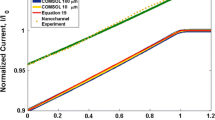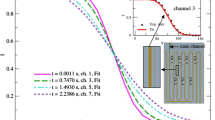Abstract
A number of methods for analyzing liquid media are based on carrying out specific reactions with the component to be determined. In microfluidic devices, due to the laminarity of the flow, it is difficult to organize uniform mixing of the reaction components, which deteriorates the reproducibility of the results of the reactions and the quality of the analysis. To improve the efficiency of passive mixing in microfluidic systems, you can use the input channel samples of variable geometry, in particular, with bends, or with a variable width. The mixing efficiency is directly related to the variability of reagent concentrations in the working area, and this characteristic is adequately evaluated through the dispersion of the concentration profile. To obtain an estimate of the dispersion of the concentration distribution, an analytical solution of the convective–diffusion equation using the method of moments is proposed. For this, the sample entry system—a straight section of constant width with an additional linearly expanding channel—is approximately replaced by an equivalent channel of constant width. Also, the values of convective velocity and diffusion coefficient are approximately replaced by averaged ones. The dispersion estimates obtained on the basis of an approximate analytical solution have an acceptable agreement with the results of numerical 2D modeling of convective mass transfer in COMSOL MULTYPHYSICS.



Similar content being viewed by others
REFERENCES
Barabash, V.M., Abiev, R.Sh., and Kulov, N.N., Theory and practice of mixing: A review, Theor. Found. Chem. Eng., 2018, vol. 52, no. 4, pp. 473–487. https://doi.org/10.1134/S004057951804036X
Yang, Z., Méheust, Y., Neuweiler, I., Hu, R., Niemi, A., and Chen, Y.-F., Modeling immiscible two-phase flow in rough fractures from capillary to viscous fingering, Water Resour. Res., 2019, vol. 55, no. 3, pp. 2033–2056. https://doi.org/10.1029/2018WR024045
Zhao, J., Ning, Z., and Lv, M., Experimental study on the two-phase flow pattern and transformation characteristics of a flow mixing nozzle under a moderate flow rate, Meccanica, 2019, vol. 54, no. 8, pp. 1121–1133. https://doi.org/10.1007/s11012-019-01014-2
Semenov, I.A., Ul’yanov, B.A., and Kulov, N.N., Experimental estimation of the vibration effect on the rate of mass transfer from a planar surface, Theor. Found. Chem. Eng., 2016, vol. 50, no. 3, pp. 231–236. https://doi.org/10.1134/S0040579516030106
Lobasov, A.S., Minakov, A.V., and Rudyak, V.Ya., Flow modes of non-Newtonian fluids with power-law rheology in a T-shaped micromixer, Theor. Found. Chem. Eng., 2018, vol. 52, no. 3, pp. 393–403. https://doi.org/10.1134/S0040579518020112
Dolomatov, M.Yu., Kazakov, M.A., and Zhuravleva, N.A., Simulation of systems with chaos in the chemical composition using stochastic methods, Theor. Found. Chem. Eng., 2017, vol. 51, no. 5, pp. 703–707. https://doi.org/10.1134/S0040579517050281
Aris, R., On the dispersion of a solute in a fluid flowing through a tube, Proc. R. Soc. London, Ser. A, 1956, vol. 235, pp. 67–77. https://doi.org/10.1098/rspa.1956.0065
Wang, J., Lin, Q., and Mukherjee, T., Analytical dispersion models for efficient simulations on complex microchip electrophoresis system, Proc. 7th International Conference on Miniaturized Chemical and Biochemical Analysts Systems MicroTAS’03, Squaw Valley, Calif., 2003, vol. 1, p. 135.
Magargle, R., Hoburg, J.F., and Mukherjee, T., An injector component model for complete microfluidic electrokinetic separation systems, Technical Proceedings of the 2004 NSTI Nanotechnology Conference and Trade Show (NSTI Nanotech 2004), Boston, 2004, vol. 1, pp. 77–80.
Barton, N.G., On the method of moments for solute dispersion, J. Fluid Mech., 1983, vol. 126, pp. 205–218. https://doi.org/10.1017/S0022112083000117
Goltz, M.N. and Roberts, P.V., Using the method of moments to analyze three-dimensional diffusion-limited solute transport from temporal and spatial perspectives, Water Resour. Res., 1987, vol. 23, no. 8, pp. 1575–1585. https://doi.org/10.1029/WR023i008p01575
Govindaraju, R.S. and Das, B.S., Moment Analysis for Subsurface Hydrologic Applications, Water Science and Technology Library, vol. 61, Dordrecht: Springer, 2007.
Fischer, H.B., List, J.E., Koh, C.R., Imberger, J., and Brooks, N.H., Mixing in Inland and Coastal Waters, New York: Academic, 2013.
Giona, M., Adrover, A., Cerbelli, S., and Garofalo, F., Laminar dispersion at high Péclet numbers in finite-length channels: Effects of the near-wall velocity profile and connection with the generalized Leveque problem, Phys. Fluids, 2009, vol. 21, no. 12, p. 123 601. https://doi.org/10.1063/1.3263704
Vedel, S., Hovad, E., and Bruus, H., Time-dependent Taylor–Aris dispersion of an initial point concentration, J. Fluid Mech., 2014, vol. 752, pp. 107–122. https://doi.org/10.1017/jfm.2014.324
Lukyanenko, K.A., Denisov, I.A., Yakimov, A.S., Esimbekova, E.N., Belousov, K.I., Bukatin, A.S., Kukhtevich, I.V., Sorokin, V.V., Evstrapov, A.A., and Belobrov, P.I., Analytical enzymatic reactions in microfluidic chips, Appl. Biochem. Microbiol., 2017, vol. 53, no. 5, pз. 775–780. https://doi.org/10.1134/S0003683817070043
Landau, L.D. and Lifshitz, E.M., Teoreticheskaya fizika: uchebnoe posobie. T. 6. Gidrodinamika (Theoretical Physics: A Textbook, vol. 6: Hydrodynamics), Moscow: Nauka, 2001.
Esikova, N.A., Bulyanitsa, A.L., Klotchenko, S.A., Taraskin, A.S., and Evstrapov, A.A., The influence of hydrodynamic conditions and chamber geometry on the analytical signal from integrated biochips, J. Phys.: Conf. Ser., 2018, vol. 1135, article no. 012 021. https://doi.org/10.1088/1742-6596/1135/1/012021
Funding
This work was completed under the terms of task no. 075-00780-19-00 of the government of the Russian Federation.
Author information
Authors and Affiliations
Corresponding author
Ethics declarations
The authors declare no conflicts of interest.
Additional information
Translated by P. Vlasov
Special issue: “Two-phase flows in microchannels: hydrodynamics, heat and mass transfer, chemical reactions”. Edited by R.Sh. Abiev
Rights and permissions
About this article
Cite this article
Bulyanitsa, A.L., Belousov, K.I. & Evstrapov, A.A. Using Analytical Solutions to Evaluate the Variability of the Distribution of Concentrations of the Components of Specific Reactions in Microfluidic Systems. Theor Found Chem Eng 54, 17–24 (2020). https://doi.org/10.1134/S0040579520010030
Received:
Revised:
Accepted:
Published:
Issue Date:
DOI: https://doi.org/10.1134/S0040579520010030




